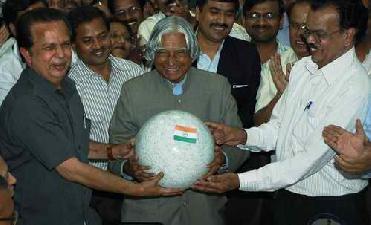
ISRO chairman Madhavan Nair and former President APJ Abdul Kalam with other scientists show a replica of moon with the Indian tricolour, Friday night. PTI Photo
BANGALORE (BNS): India marked its presence on the lunar surface on Friday evening after a Moon Impact Probe (MIP), painted with national tricolour, landed on the surface of the Moon.
With this historic landmark, India became the fifth entity after Russia, the United States, the European Union and Japan to mark its presence on the moon.
“Just as we had promised, we have given India the moon,” G Madhavan Nair, chairman of the Indian Space Research Organisation, said minutes after the MIP mission carried through successfully. Flanked by former President APJ Abdul Kalam and several ISRO scientists at the ISRO Telemetry, Tracking and Command Network (ISTRAC), Nair said, “It was during Jawaharlal Nehru’s time that the nucleus for a space programme started. It is befitting that on children’s day, celebrated in his honour, that India should plant its flag on the lunar surface.” The landing on the Moon coincided with Children’s Day, observed to mark the birth anniversary of country's first Prime Minister Jawaharlal Nehru.
Dr Kalam said India’s moon mission has “kindled a great interest in young minds.” The eminent scientist said he was hopeful that India “will be able to have young astronauts walk on the Moon’s surface in 15 years.”
The MIP crashed on the lunar surface at 8.31 pm IST, after it ejected at 8.06 pm. ISRO described the landing of MIP as a ‘perfect operation’. They said that the MIP was a technological forerunner to Chandrayaan-2, which would soft-land a rover on the Moon in 2012-13.
An ISRO official said MIP, weighing 34 kg at the time of its launch onboard Chandrayaan-1, the box shaped payload carries three instruments – a video imaging system, a radar altimeter and a mass spectrometer. “The video imaging system is intended to take pictures of the moon's surface as MIP approaches it. The radar altimeter will measure the rate of descent of the probe to the lunar surface. Such instruments are necessary for future lunar soft landing missions. And, the mass spectrometer was for studying the extremely thin lunar atmosphere,” the official said.
Describing the MIP's 25-minute journey to the lunar surface, ISRO said that it began with its separation from Chandrayaan-1 spacecraft at 8.06 pm. This was followed by a series of automatic operations that began with the firing of its spin up rockets after achieving a safe distance of separation from Chandrayaan-1. Later, the probe slowed down with the firing of its retro rocket and started its rapid descent towards the moon's surface. MIP radioed information from its instruments to Chandrayaan-1. The spacecraft recorded this in its onboard memory, and later transmitted it back to the earth.
The probe had a hard landing on the lunar surface that terminated its functioning, ISRO said.
With this India's very first attempt to send a probe to the moon's surface from its spacecraft orbiting the moon has been successfully completed, the official said.
The official said, by now two of Chandrayaan-1's payloads – Terrain Mapping Camera (TMC) and Radiation Dose Monitor (RADOM) – have been switched on during its journey to moon, and now the MIP has successfully crashed onto the lunar surface. The remaining eight payloads of the spacecraft will also be tested.
Chandrayaan-1 was successfully launched by PSLV-C11 on October 22, 2008 from India's spaceport at Satish Dhawan Space Centre (SHAR), Sriharikota into its intended initial elliptical orbit around the Earth. Following this, the spacecraft's orbit was raised in steps and it was made to pass near the Moon by repeatedly firing its 440 Newton liquid engine. After Chandrayaan-1's entry into its planned lunar orbit on November 8, 2008, the orbital height was reduced in steps to its intended operational altitude of 100 km from the lunar surface.
Since its launch, the health and orbit of Chandrayaan-1 is being continuously monitored from the Spacecraft Control Centre of ISRO's Telemetry, Tracking and Command Network (ISTRAC) at Bangalore with critical support from antennas of Indian Deep Space Network (IDSN) at Byalalu. IDSN antennas have also received the images and scientific information gathered by TMC, RADOM, and more recently, by MIP.
 Previous Article
Previous Article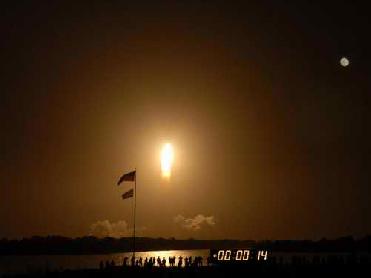 Next Article
Next Article
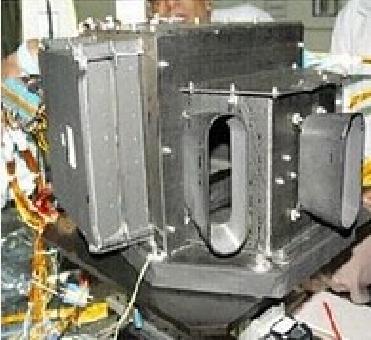

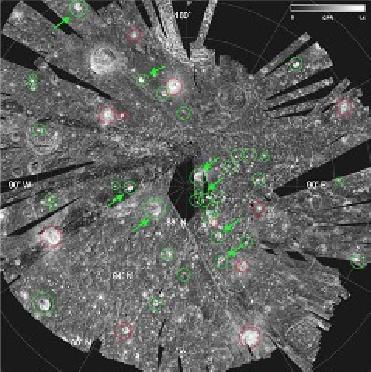
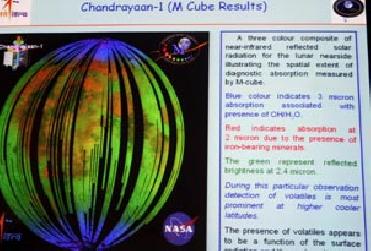









The Indian Air Force, in its flight trials evaluation report submitted before the Defence Ministry l..
view articleAn insight into the Medium Multi-Role Combat Aircraft competition...
view articleSky enthusiasts can now spot the International Space Station (ISS) commanded by Indian-American astr..
view article